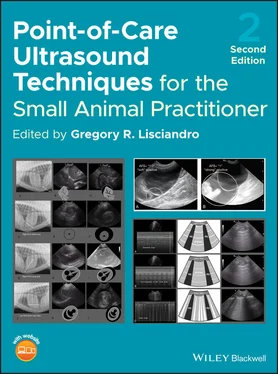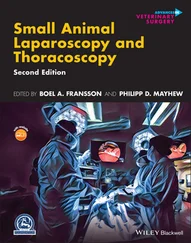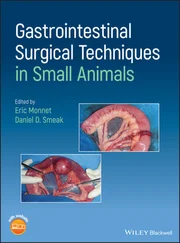Gregory R. Lisciandro, DVM, Dipl. ABVP, Dipl. ACVECCCo‐owner Hill Country Veterinary Specialists CEO, FASTVet.comPresident, International Veterinary Point‐of‐care Society (IVPOCUS) Spicewood, Texas, USA
Stephanie C. Lisciandro, DVM, Dipl. ACVIM (Internal Medicine)Medical Director, Oncura Partners, LLC Austin, Texas, USA
Alice MacGregor Harvey, Medical IllustratorNorth Carolina State College of Veterinary Medicine Raleigh, North Carolina, USA
Anne‐Christine Merveille, DVM, MSc, PhD, Dipl. ECVIM‐CA (Cardiology)Assistant Professor, Faculty of Veterinary Medicine Liège University Liège, Belgium
Debra P. Moore, DVMAssistant Clinical Professor, Mississippi State University, College of Veterinary Medicine Institute for Marine Mammal Studies Gulfport, Mississippi, USA
Pablo E. Otero, MV, PhDProfessor, Head of Anesthesiology and Pain Management Department Facultad de Ciencias VeterinariasUniversidad de Buenos AiresBuenos Aires, Argentina
Suji Park, IllustratorEnglewood Cliffs, New Jersey, USA
Diego A. Portela, MV, PhD, Dipl. ACVAAAssistant Professor, Anesthesiology and Pain Management Department of Comparative, Diagnostic, and Population MedicineCollege of Veterinary MedicineUniversity of Florida Gainesville, Florida, USA
Daniel Rodríguez, MVZ. Esp. Dipl ACVRMedical Director, VETTEM México Chapultepec, Mexico City, Mexico
Susanne M. Stieger‐Vanegas, Dr Med Vet, PhD, Dipl. ECVDIAssociate Professor, Diagnostic Imaging Camden Professor Radiology Department of Clinical Sciences Carlson College of Veterinary Medicine Oregon State University Corvallis, Oregon, USA
Randi Taggart, IllustratorRichmond, Virginia, USA
Enrique Yarto, MVZ, M.C.Centro Veterinario México‐Animales Exóticos Presidente Instituto Mexicano de Fauna Silvestre yAnimales de Compañía IMFAC, S.C. Ciudad de México, México
Sarah Young, DVMEcho Service for Pets Ojai, California, USA
Over the past three decades, the technological miniaturization of ultrasound machines has made compact, portable ultrasound devices, ranging from pocket‐sized devices to laptop‐style machines, available to healthcare providers at the bedside. Healthcare providers are using ultrasound to look inside the body during their bedside evaluation of patients, which has given rise to a new field of clinical medicine called point‐of‐care ultrasound . Point‐of‐care ultrasound is defined as a goal‐directed, bedside ultrasound examination performed by a healthcare provider to answer a specific diagnostic question or guide performance of an invasive procedure at the bedside. Providers from nearly all healthcare professions have begun to learn how to use point‐of‐care ultrasound, and veterinary medicine is ideally suited for integration of point‐of‐care ultrasound given the diverse complaints and wide range of animals that are cared for by veterinarians on a daily basis.
The first edition of this book, called Focused Ultrasound Techniques for the Small Animal Practitioner , was published in 2014 and described the most common focused ultrasound examinations in veterinary medicine. The first edition established a standardized approach to perform a multisystem veterinary ultrasound examination, particularly of the heart, lungs, and abdomen, and has served as a guide for veterinarians to incorporate ultrasound into their clinical practices around the world. The book has been translated into Spanish, Chinese, Greek, Japanese, and Polish, and over 2000 copies have been sold worldwide.
In this second edition, the reader experience has been enhanced in several ways. The core chapters describing the fundamental veterinary ultrasound examinations have been expanded to discuss a broader range of species, including exotic species, and a more in‐depth discussion of feline species. Several new chapters have been added, including chapters on the use of ultrasound to evaluate marine mammals and zoo animals. Chapters on the nervous system describe evaluation of the brain and peripheral nerves, as well as performance of ultrasound‐guided nerve blocks. The online video library has been expanded to include over 100 videos of normal and abnormal findings to supplement the book chapters.
For veterinary clinicians seeking to improve their knowledge and skills in point‐of‐care ultrasound, this book has evolved to become a standard reference for its high‐yield chapters, online video content, and practical teaching points written by experts in the field.
Nilam J. Soni, MD, MSc Associate Professor of Medicine Department of Medicine University of Texas Health San Antonio San Antonio, Texas, USA
POCUS is point‐of‐care ultrasound. Veterinary POCUS (V‐POCUS), which includes FAST ultrasound examinations, is defined as a goal‐directed ultrasound examination(s) performed by a veterinary healthcare provider at the point of care (cageside) to answer a specific diagnostic question(s) or guide performance of an invasive procedure(s).
The translational study from the human to the veterinary patient regarding the focused assessment with sonography for trauma (FAST) exam by Dr Søren Boysen and colleagues in 2004 was a landmark study opening the eyes of the veterinary world to the nonradiologist, noncardiologist use of ultrasound, and that the principle of FAST ultrasound, that the nonradiologist sonographer is able to recognize anechoic triangulations representing free cavitary fluid, was not only achievable but also had the potential to improve patient care and save lives.
The following year, 14 years after graduating from veterinary school, I began my residency training in emergency and critical care in San Antonio, Texas, a city supportive of military training with several bases, and thus a mecca for FAST ultrasound. At the time, my program mentor encouraged me to take on FAST ultrasound as my clinical research requirement. I balked at the idea, having failed a complete abdominal ultrasound course in 1999, six years earlier, and thus concluding that ultrasound was a skill I would never master. However, I finally agreed to read the Boysen et al. study, after which I thought: “This (FAST ultrasound) willimprove patient care. And I only have to be able to recognize black (anechoic) triangles. I like anatomy and surgery. I canmemorize four views. It’s only four views.”

Thus, I decided that I would give ultrasound one more try. The FAST study intrigued me in the numbers of dogs with occult injury missed with traditional screening tests of physical exam, baseline blood and urine testing and radiography, but captured using FAST ultrasound. The study raised many fascinating questions, including looking past the diaphragm, adding a fluid scoring system to better categorize a positive FAST examination, and exploring the thorax with its own FAST format. Thus, my unimaginable journey began with developing AFAST, its target organ approach and its fluid scoring system; developing TFAST for pneumothorax, pleural and pericardial effusion, and its echo views for cardiac abnormalities; and most recently Vet BLUE (Veterinary Brief Lung Ultrasound Exam). Initially (2005), we combined AFAST and TFAST and referred to the study as “Combo (Combination) FAST” because we quickly realized how important it was to screen both cavities. Combining these three formats circa 2010, the study is now referred to as Global FAST and serves as an extension of the physical exam.
Читать дальше













